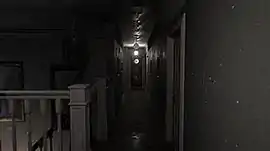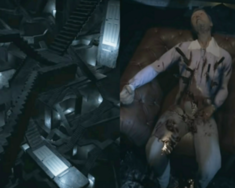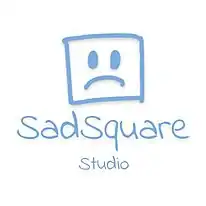Visage (video game)
Visage is an independent psychological horror video game by SadSquare Studio. Set in a strangely-structured house with a somber history, players control Dwayne Anderson as he explores the backstories of every inhabitants that once lived there. Mainly inspired by the cancelled project of P.T., the game ran Kickstarter and Steam Greenlight campaigns. It was later released on October 30, 2020, and received positive reviews.
| Visage | |
|---|---|
 Splash screen of the game | |
| Developer(s) | SadSquare Studio |
| Publisher(s) | SadSquare Studio |
| Designer(s) | Jonathan Vallières |
| Programmer(s) | Jonathan Gagné |
| Artist(s) |
|
| Writer(s) | Victoria Suchanek |
| Composer(s) | Peter Wicher |
| Engine | Unreal Engine 4 |
| Platform(s) | |
| Release | October 30, 2020 |
| Genre(s) | Survival horror |
| Mode(s) | Single-player |
Gameplay

Visage has a similar setting and gameplay as its spiritual predecessor P.T.. The game takes place in a large suburban home in the 1980s and utilizes a first-person-perspective. The player controls Dwayne Anderson, an inhabitant of the home who committed suicide after killing his wife and children. Dwayne is trapped inside the house and is tormented by supernatural entities. The objective of the game is to find a way out of the house and learn about the cause of all the paranormal activity.
The house is designed as a semi-open world, with large sections freely explorable to the player at all times and multiple pathways to reach each area. However, in order to fully explore the map, players will need to find keys to unlock each door first. The player must face several hazards while exploring. First, they will have avoid dark areas to manage their sanity. Sanity, like similar systems in games such as Amnesia: The Dark Descent, is decreased if Dwayne stays in the dark for too long.
Secondly, ghosts will create paranormal events by manipulating the house as the player explores. Examples include light bulbs breaking, doors slamming or opening, and electronic devices malfunctioning. Witnessing these events will cause Dwayne's sanity to fall. Lastly, Dwayne must avoid being caught by the various ghosts and demons that inhabit the home. Being caught by these ghosts and demons means instant death, so players must carefully maneuver through the house to avoid them. The lower Dwayne's sanity, the more severe each paranormal event becomes, up to the point that a ghost or demon will appear and attack the player.
Players can use lighters, pills, light bulbs, and candles to help them avoid these threats. Lighters allow the player to move through dark areas without a light, taking pills can recover sanity, light bulbs can be used to repair broken lights, and candles are a light source that ghosts cannot manipulate. There are various other items the player can find and use, like a camera or a sledgehammer.
Dwayne has a very limited inventory and can store only five of these items at a time, and hold two more in his hands. As a result, the player must explore the house very carefully to uncover the truth.[1]
The fourth chapter of the game is divided into seven subchapters; in each subchapter, players are objected to find VHS tapes scattered through the house, each labeled differently; Pride, Negligence, Indifference, Prison, Addiction, and Greed.[2]
Plot
Visage is split into four chapters that can be completed in any order. Each chapter centers around a different person who once lived in the suburban home the game takes places in.
The game opens in the 1980s, with a scene in which a man, Dwayne Anderson,[note 1] shoots and kills his wife and two children before committing suicide. Moments later, Dwayne wakes up in an empty room covered in blood. After he stumbles out of the room, his neighbor Rose calls on the landline, and claims that she hasn't seen Dwayne leave the house in three weeks. He tries opening the front door but it is locked. Paranormal events begin occurring throughout the house, and Dwayne begins searching the house for a way out.
Lucy's Chapter
Lucy was an innocent young girl who loved birds, and she had a pet bird, Peaco. However her behavior became abnormal, and she claimed she has imaginary friends, which was, in reality, a demon influencing her. The demon appeared to Lucy for the first time, emerging from a TV.
One day Lucy, under possession of the demon, murdered Peaco and blamed it on the demon. Her father suggested to her mother to take her to therapy. When a therapist was hired, her mother disliked his treatment method, as it involved syringing medicine to Lucy. Her father thought otherwise.
A blood-pooled tub with bloody writings is seen. On an unknown date, Lucy is possessed by the demon, committing suicide by ejecting her own jaw before her parents could enter the bathroom she locked herself in.
Dolores' Chapter

Whilst roaming around, Dwayne sees a photograph of the past two adult inhabitants of the house: spouse Dolores and George. A long-reaching hook tears George's right eye. Dwayne uses it to open the attic ladder, and reaches a Victorian-style bedroom, in which each corner of the left wall has a peephole. In an audiocassette, George says that Dolores is reported to have symptoms of schizophrenia, bipolar, psychosis, dementia, and more, however the exact disorder is hard to be determined. Dolores told George she had been hearing her own voices whispering five numbers via their baby's monitor, which is "the key to her inner house." George thinks the treatments given are not helping. In another cassette, George rants that he is overwhelmed with this family burden.
Back in the regular part of the house, he learns that oval mirrors in the house have an unsettling nature. Dwyane finds a sledgehammer, using it to shatter all oval mirrors in the house. These mirrors act as shortcuts to various parts of the house. One of the mirrors lead to the dining room. In the fashion of a flashback, Dolores sits at the table, where George has just arrived for tea time. George grabs the tea box, but amidst in her moments of paranoia, Dolores thinks it is rodenticide, and blinds his eye. Dwayne later learns that George was addicted to drugs and is an alcoholic. Dolores murdered George with seven knives at his ribs, placing his corpse at his study desk. A finding of George's corpse features an IV bag at his hand.
Dwayne grabs a baby monitor. He reaches at a corridor junction with clocks hung in every corner, not ticking. Via the monitor, Dolores says the five numbers she reportedly hears through the monitor: 50373. Dwayne follows the clock pattern, and finds a vinyl disk at the attic bedroom, places it at a phonograph cylinder in the living room, automatically playing "Frühlingsstimmen" in another room: a convoluted maze with various trails and littered with doors, her "inner house." If Dwayne goes on the wrong path, the music turns somber; otherwise, the music remains. At a window, Dolores is seen dancing with thin air, presumably George, hinting a once-existed harmony in the household. Opening the right door, features a twisted hallway, getting redder and smokier as he travels further. He opens a door, leading to the room visible from the bedroom's peephole earlier. Through each peepholes a history is puzzled: in the aftermath of George's murder, Dolores puts the baby in the bassinet and goes to the room's corner, where she hangs herself.
Rakan's Chapter
28-year-old Rakan Al-Mutawa is in a corner desk, stressed that "it" is back. At a room, he throws all books from a shelf, and then finds "it" at the corner, yelling. "It", a shadow, later approaches and strangles him. Although he used a firearm to defend himself, the attempt fails miserably. As police arrive, Rakan is interrogated; he says that "it" broke into his house, and that everyone in the world is responsible for the incident. In an interview with a therapist, Rakan claimed that the incident is an attempt by an evil corporation to brainwash him into subjugation. Police found no signs of break-in. Minor bruises are seen, however, it is concluded that they are self-inflicted. His medical background has scopophobia, fear of being stared, recorded in it. Later gameplays feature scopophobic hallucinations to drown Dwayne into the perspective of Rakan's.
He is brought to a psychiatric hospital. He repeatedly opposes having treatments. A frequent harasser of the staff members, he caused code white alarms to skyrocket. Aside from a failed attempt to jump from a window, Rakan kills a staff member with a crowbar. Doctors treat the havoc by syringing him with a tranquilizer, although it did not cure it: he sabotages the building panel, temporarily bringing it under lockdown.
In response, he is placed in a room isolated from all patients and staff. A few months later, doctors conclude that Rakan's psychology is recovering, and that he is officially discharged. Later, Rakan, now a disabled person, declares a revenge to the evil corporation. The room is locked by a tall figure, and the lights go out as Rakan screams in agony.
Chapter 4
At a weirdly-placed lounge with an alcoholic drink on the table (referred to as "the wonderful poison"), a TV plays a live video of a masked man talking to Dwayne, saying that all the bedlams he has been through is the first time he is in reality. The man angrily seeks to get an answer as to who Dwayne truly is.
At the living room, Dwayne is flashed back to when his family, wife Claire and daughter Sarah, is still alive. Dwayne, an alcoholic, distances himself from Sarah. Sarah requests a bedtime story, but Dwayne, like he is recently, does not even talk. Claire shouting at Dwayne also gives no response. As he drinks a beer, he chokes on an object and vomits blood.
Dwayne discovers a chained door, and he unchains it. At another door, where a humanoid is painting the crucifixion of Jesus. Going in the unchained door, Dwayne enters Hell: a tall and wide cave, where people make sufferings by themselves. The masked man claims that thanks to Dwayne, everyone in Hell "enjoys their newfound home."
In a flashback, Claire discovers that Dwayne has been abusively consuming Chlorpromazine to relieve stress. Claire begs him for an answer as to why all the drugging and drinking, so that the household and go back to harmony. Claire asks if he is thinking of leaving her and Sarah, as well as whether he is slowly killing himself. However through Dwayne's senses, it is revealed that Claire marries Dwayne simply for money. Claire throws suggestions of suicide methods, all of which are the causes of death of the previous inhabitants in the house. She then belittles and wishes death upon him.
Dwayne is revealed as a former scientist who started working at a water treatment plant in Riversdale, Maryland in April 1952. At the plantation, Dwayne drops an apple to a well, which causes dead bodies to float. He faints and wakes up at the house.
Endings
The game has multiple endings. In the default ending, Dwayne wears a mask and it is day. He later enters a room bordered by a haphazardly-painted wall, and teleports to a white screen with his family from the distance. The credits' background feature a heavenly rainforest.
In the alternate ending, nicknamed "The Void", Dwayne goes to the basement, where he breaks through the wall. Opening a secret door and going down a stair, he reaches the room in the game's opening, with the revolver there. Dwayne shoots himself like he did in the opening. In a flash, he sees the location of one of the seven VHS tapes needed to collect to achieve the default ending. After collecting one, time repeats itself six times— in the last time, the revolver is already empty. Dwayne wakes up in the well in Chapter 4, endless in all directions. Soon, the credits roll. If the player plays via Steam or console, they will receive the Void Trophy.
Development and release

Visage started development in January 2015 and was announced in September 2015. The game was successfully financed by a Kickstarter campaign running from January through March 2016.[3] They set the goal to CAD35,000.[4] On October 2015, a Steam Greenlight campaign was launched,[5] featuring a trailer embedded in the page.[6] In an interview with IGN, the developer, SadSquare Studio, stated that the game is conceptualized to mainly utilize "the uncanny" to create a sense of dread and fear. It was inspired by P.T.., the teaser for Silent Hills; graphics designer Jonathan Vallières stated that the project's cancellation motivated the creation of the game. Other inspirations include The Conjuring, Insidious, Sinister, Ju-on, Ringu, Kairo, and Phantasmagoria.[7][8]
The developers initially targeted the release date to be on January 2017, in both computers (PC) and virtual reality (VR).[8] On September 25, 2018 the developers announced that a demo of Visage would be released on October 2, 2018. The demo version for Visage was released on Steam on October 2, 2018, and that it was planned for release on early 2019.[9] After a long delay, on February 15, 2020, SadSquare Studio announced that "the main content of Visage is pretty much done", and that they were projecting for a fall 2020 release.[10] It was released on October 30, 2020, amidst the COVID-19 pandemic. In addition to PC, it was also released on PlayStation 4 and Xbox One.[11]
See also
- Allison Road – another first-person horror game considered to be a spiritual successor to P.T.
Note
- Implied via a radio saying "We have a special guest with us today... His name is Dwayne Anderson... He killed his whole family."
References
- "Visage The Game". SadSquare Studio. 3 October 2017. Archived from the original on 28 December 2020. Retrieved 5 February 2019.
- "Every VHS Tape Location in Visage". ScreenRant. 4 November 2020. Archived from the original on 28 December 2020. Retrieved 23 December 2020.
- "Visage — Psychological horror game". Kickstarter.
- Guarino, Mike (8 February 2016). "New Horror Game Kickstarter Visage Inspired By P.T. And Silent Hill | AOTF". Attackofthefanboy.com. Archived from the original on 11 February 2016. Retrieved 23 June 2017.
- "Visage Brings Its Haunted-House Horror to Greenlight". Hardcore Gamer. Archived from the original on 28 December 2020. Retrieved 23 December 2020.
- "Atmospheric Psychological Horror Game Visage Hits Kickstarter With New Trailer". Hardcore Gamer. 27 January 2016. Retrieved 23 June 2017.
- "VISAGE DEVS SPEAK ABOUT P.T. INFLUENCE, GAME LENGTH, AND MORE – IGN FIRST". IGN. 5 October 2017. Archived from the original on 29 July 2020. Retrieved 3 February 2018.
- Rad, Chloi (5 February 2016). "Visage Is a Hyper-Real Horror Game in the Style of P.T." Ign.com. Archived from the original on 29 July 2020. Retrieved 23 June 2017.
- Gutierrez, Yaris; Gutierrez, Yaris (30 October 2018). "Visage is a Terrifying Experience That Feels Like What Silent Hills Could Have Been". DualShockers. Archived from the original on 28 December 2020. Retrieved 5 February 2019. Missing
|author2=(help) - "Psychological horror game Visage launches October 30 for PS4, Xbox One, and PC. Game was released at October 30". Gematsu. 23 October 2020. Archived from the original on 28 December 2020. Retrieved 24 October 2020.
- Tack, Daniel. "Horror Game Visage Releases On October 30". Game Informer. Retrieved 23 December 2020.
